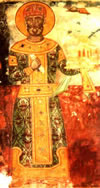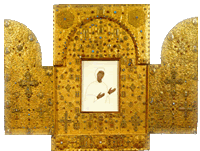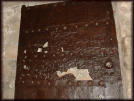|
GELATI
- Short Tour
|
(Article written with help of Gelati experts. Credits - World66.com )
 The
Gelati Monastery , once a major centre of enlightenment in Georgia
for many long centuries, was a repository of many outstanding monuments
of art, and still is even today.
The
Gelati Monastery , once a major centre of enlightenment in Georgia
for many long centuries, was a repository of many outstanding monuments
of art, and still is even today.
The monastery was founded by King David the Builder in 1106. As a result
of the progressive policy he pursued as well as a favourable international
situation, Georgia became a powerful feudal monarchal state which subordinated
neighboring countries to its influence and sought to play a leading role
among all those of the Near East.
Wishing to establish in his homeland a center of enlightenment which would be in no way inferior to any of the renowned hearts of culture in Byzantium or in countries of the Near East, King David the Builder founded an academy at the Gelati Monastery and invited to teach there the most outstanding Georgian theologians, philosophers and doctors of law, many of whom had previously been active at various monasteries abroad or at the Mangan Academy in Constantinople. Mosaic presenting the Virgin with Archangels - Michael & Gabriel (1125-1130) About 200 meters north-west of the Gelati ensemble, lie the ruins called Sokhasteri (hermits' dwelling place). The cleaning and research carried out on this spot showed that once a hospital was sited there and, according to the chronicle, David the Builder had erected it and personally supervised the care of the patients.
Portrait of King David the Builder with a model of the Cathedral in his hand (16th cent) The Gelati Monastery has preserved a great number of murals dating back to the 12th-18th centuries. They adorn both the main Cathedral consecrated to the Nativity of the Virgin and the Church of St. George. The murals in the main structure combine two kinds of monumental medium-mosaic and frasco. The mosaic occupies a small yet the most important place in the overall mural, while the rest is done in fresco technique. The latest renovations were done in oils in the 19th century.
Apostles and the Church Fathers(13th cent) However, the refined "psychological" type, common for Byzantine and Georgian art alike, reveals certain features, sometimes very subtle, typical of the local national type. Apostles Receiving the Eucharist (16th cent) The murals of the late 12th century and early 13th, which without doubt once adorned the Gelati Monastery (specifically the Church of St. George), have not survived. Today the second chronological layer of the Gelati murals is represented by the 13th-century frescos (c. 1291-1293) that adorn the east compartment of the main Cathedral's south chapel. In its time the chapel served as the burial vault of King David VI (Narin), the son of Rusudan. Our Lady's Day (16th cent) This mural is notable for its highly developed paleologue style which is quite unexpected for work done at the end of the 13th century. The third chronological layer of the Gelati murals is represented by surviving fragments in the south chapel. Judging by the portrait of King Bagrat V, they date from the last quarter of the 14th century St. Constantine and St. Helen (16th cent) Frescos of the 14th century have also been preserved in a few other parts of the Cathedral. The portrait of Bagrat V is the last of the surviving representations of kings of a united Georgia. All the portraits of later dates show kings of West Georgia, i.e. sovereigns of Imeretia Fresco (16th cent) The next chronological layer is represented by a double portrait exposed recently from beneath a 16th-century mural in the central part of the north chapel. The Nativity (17th cent) In 1510, following a surprise attack on West Georgia, the Turks seized Kutaisi, looting and burning the Gelati Monastery. It is supposed that the ancient burial vaults of the Georgian kings were ravaged. The murals, without doubt, might also have suffered from a fire. The Entry into Ierusalem (17th cent) At any rate, it is quite obvious that the murals in the central part of the main Cathedral, as well as those in the Church of St. George, suffered most, for they were all painted over in the 16th century.
The Descent of the Holy Spirit (17th cent) The paintings in the Cathedral cupola were executed by an artist named Tevdore, apparently in the 17th century. Until recent times the gelati Monastery housed ancient manuscripts and unique examples of embossed precious metal.
 The
Ascension (17th cent) Some of the latter are embellished with enamel as,
for instance, the superb casing for the Khakhuli icon made in the second
half of the 12th century. This icon had been moved to Gelati from the
Khakhuli Monastery. In Gelati a casing was made for it, the central part
being of gold, and the lateral wings of silver gilt. The inscription on
the icon mentions King David the Builder and his son Demetre.
The
Ascension (17th cent) Some of the latter are embellished with enamel as,
for instance, the superb casing for the Khakhuli icon made in the second
half of the 12th century. This icon had been moved to Gelati from the
Khakhuli Monastery. In Gelati a casing was made for it, the central part
being of gold, and the lateral wings of silver gilt. The inscription on
the icon mentions King David the Builder and his son Demetre.
END of Article
The Gate of Ganja
 In
1139 Georgian king Demetri I (1125-54) attacked Moslem city Ganja, which
was destroyed by the earthquake, and took the gates to Georgia . Gates
are still kept in Gelati Monastery).
In
1139 Georgian king Demetri I (1125-54) attacked Moslem city Ganja, which
was destroyed by the earthquake, and took the gates to Georgia . Gates
are still kept in Gelati Monastery).
The Gates of Ganja- a pattern of mediiaval Azery artistic craft. Master
Ibrahim Ibn Osman made it in 1063, to the Sheddadi ruler Shavur's order.
Destined either for the Ganja fortress or inner fortress, the gates are
embellished with stamped designs and ornaments. The gates have Kufi
inscriptions which tell us that this gate was made to Shavur's order:
name of the master, the date ("...blacksmith Ibrahim ibn Osman
ibn Angaveh, 455 year).
One part of the gate was used for covering a shed during repair works
in XVIII century. The other part is now secured to the South wall of Gelati
monastery (the wall in front of of David IV tomb).
Armazi Project - Great Collection of Gelati Images
View Gelati Photo Gallery or Gelati Slideshow

